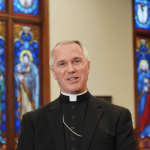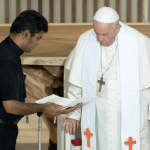OTTAWA (CCN) — Four letters and 26 promises from Canada’s bishops to Indigenous Canadians set an agenda for reconciliation that bishops like Calgary’s Bishop Bill McGrattan intend to act on before February turns into March.
McGrattan has scheduled meetings with members of the Indigenous Reconciliation Fund committee in his diocese. The committee — there are similar committees in dioceses across Canada — makes recommendations for local Calgary projects that could be funded by the national $30 million reconciliation fund Canada’s bishops have set up. McGrattan has forwarded the letters to Inuit, First Nations and Metis committee members and hopes for their feedback.
“This is an opportunity for me to again meet with them and to have a chance to discuss it and to listen to them as to how we can work and implement (the promises contained in the letters),” said McGrattan.
The letters — addressed to First Nations, Inuit, Metis and Canadians in general and released by the Canadian Conference of Catholic Bishops Feb. 8 — are an exercise in the Vatican II principle of subsidiarity, emphasizing local decision-making, the bishop said.
Deacon Harry Lafond, former Chief of the Muskeg Cree First Nation in northern Saskatchewan, hopes the letters are also a step forward in building a more synodal Church in Canada. He wants the bishops to use the letters “to make this pre-amble into a meaningful exercise that leads to something in the generations to come,” he said.
“The synodal process that Pope Francis has introduced discussion on is part of the answer that can help us,” Lafond said. “Because it really emphasizes the local voice.”
There needs to be more urgency in advancing reconciliation between the Church and Indigenous Canada, said Lafond.
“Gosh, the Catholic Church and Indigenous people have moved way far apart in that relationship. And it just gets worse. Every year it gets a little bit worse, a little bit more distant,” said Lafond, who served at the altar of Pope Francis’ Mass at Commonwealth Stadium in Edmonton in July. “My fear is that in two or three generations it will be like two completely separate entities. The Indigenous people will go in their own direction with their spiritual development, their spiritual institutions, their spiritual organizations.”
In parallel with the September 2021 apology, the pastoral letters are issued through the CCCB but are statements to which each bishop individually has committed. The broad, general promises made in the three letters to Indigenous Canadians will take different forms in different dioceses.
“Each of us, as leaders of our dioceses and eparchies, pledges to walk with you into a new era of reconciliation, particularly at the local level,” said the Pastoral Letter to the Metis.
The “Walking Together” theme, which headlined Pope Francis’ tour of Canada last summer, is heavily emphasized in all four pastoral letters. The letters bear the official logo of the Walking Together papal visit.
Walking together isn’t some kind of simple, universal formula for achieving reconciliation, said Churchill-Hudson Bay Bishop Anthony Krotki.
“We are preparing ourselves right now as a diocese to understand what it really means, walking together,” Krotki said. “We know from Inuit tradition and the history and the values and the culture what walking together means in different moments of life. It’s a different walking.”
Reconciliation won’t be accomplished by any one act or gesture, said the Oblate bishop of a vast territory that includes all of Nunavut.
“That moment of closure, the moment of unification of both sides, it may still be ahead of us,” Krotki said.
Reconciliation will only happen locally and only by sustained dialogue, said Winnipeg Archbishop Richard Gagnon.
“Where the specifics come in is in the dialogue between the bishops and the Indigenous leaders across the country. It’s not just coming from the bishops… What I do here in Winnipeg (will be) quite different than, let’s say, on Vancouver Island or some place in Ontario,” Gagnon said. “It all depends on the openness of both parties. It’s not one-sided.”
The letters were written with input from the three national Indigenous organizations, said a CCCB spokesperson. The Inuit Tapiriit Kanatami, Assembly of First Nations and Metis National Council had collaborated with the CCCB on organizing delegations to visit Rome in March and April last year, and on the Pope’s visit to Canada in July.
The purpose of the letters is to “renew our profound sorrow for past harms and recommit ourselves to finding new ways to accompany Indigenous peoples in their pursuit of justice, healing and reconciliation,” said the Pastoral Letter to the First Nations.
That’s one promise Lafond hopes will be realized.
“The Catholic Church, in my experience, is kind of quiet when it comes to justice issues,” the deacon said.
In all three letters to the Indigenous, the bishops ask Indigenous Canadians to stick with them and stick with the Church.
“We ask you to continue to walk side by side with us along the path of hope,” said the Pastoral Letter to First Nations.
In a separate, four-page letter to the “People of God in Canada” the bishops make the case for a hard, honest look at Canada’s history “that increasingly marginalized Indigenous peoples and disrespected and denigrated Indigenous ways.”
“This is a dark and tragic part of the Canadian story. Insofar as members of the Church participated in it, it also remains a dark and tragic part of the Christian story in this land.”
Metis elder and Edmonton Catholic School Division cultural facilitator Gary Gagnon is willing to go along with the idea that the bishops’ commitments will take different forms in different parts of the country. Gagnon is looking for the Canadian bishops to follow in Pope Francis’ footsteps.
“It took an old man to say ‘I’m very sorry on behalf of the Catholic Church.’ He shouldered that for them,” Gagnon said.
Gagnon wants his Church to be a listening Church.
“I hope they will listen. Listening is free, by the way,” he said. “It also gives the person across from you a sense of love, I would like to think. It means you care enough to pay attention.”
The bishops also urge Canadian Catholics to listen.
“Listening and dialogue are keys to building upon the relationships developed in recent months,” the bishops write in their letter to the entire Canadian Church. “We have spoken clearly about our desire to listen and learn how to walk together with Indigenous communities in new ways.”
The Church in Canada is irrevocably on a new path, said Winnipeg’s Gagnon.
“The whole process leading up to the delegations to Rome — all of the consultation, all of the walking together, all of the sharing information between the Church and Indigenous people, leading up to those special encounters with the Holy Father — that whole process has fed into these commitments (in the pastoral letters) and given them new life in that respect,” he said.
The Winnipeg archbishop cites the Indigenous Reconciliation Fund as an example of the new way of doing things.
“The $30 million in fundraising efforts across the country also takes into consideration the work of local, Indigenous elders and knowledge keepers who work with the dioceses giving advice, commentary and help in the distribution of these funds,” he said. “That requires dialogue. It requires engagement together.”
As Canada’s bishops issue the letters, the Indigenous Reconciliation Fund stands at $9,007,503.37. The commitment for $30 million runs another three and a half years.
“People are going to read those letters. Some will say, ‘Good.’ Some will say, ‘No good, not good enough.’ What do we do?” asked Krotki. “Are we going to put our heads down and hide? No, we can’t do that. We need to find a way to walk together. We need to find that way… This is a process that is not going to end today. We all know that this is going to last.”



